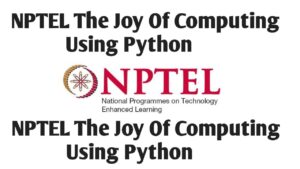Nptel The Joy of Computing Using Python Week 5 Assignment Answers
Searching for the Week 5 answers of the Nptel The Joy of Computing Using Python course? You’re in the right spot! Here, you’ll find reliable and up-to-date solutions to help you complete your Week 5 assignment with confidence.

The Joy of Computing using Python
ABOUT THE COURSE :
INTENDED AUDIENCE : Any interested audience
PREREQUISITES : 10th standard/high school
INDUSTRY SUPPORT : Every software company is aware of the potential of a first course in computer science. Especially of a first course in computing, done right.
COURSE LAYOUT – Click To Know More
- Motivation for Computing
- Welcome to Programming!!
- Variables and Expressions : Design your own calculator
- Loops and Conditionals : Hopscotch once again
- Lists, Tuples and Conditionals : Lets go on a trip
- Abstraction Everywhere : Apps in your phone
- Counting Candies : Crowd to the rescue
- Birthday Paradox : Find your twin
- Google Translate : Speak in any Language
- Currency Converter : Count your foreign trip expenses
- Monte Hall : 3 doors and a twist
- Sorting : Arrange the books
- Searching : Find in seconds
- Substitution Cipher : What’s the secret !!
- Sentiment Analysis : Analyse your Facebook data
- 20 questions game : I can read your mind
- Permutations : Jumbled Words
- Spot the similarities : Dobble game
- Count the words : Hundreds, Thousands or Millions.
- Rock, Paper and Scissor : Cheating not allowed !!
- Lie detector : No lies, only TRUTH
- Calculation of the Area : Don’t measure.
- Six degrees of separation : Meet your favourites
- Image Processing : Fun with images
- Tic tac toe : Let’s play
- Snakes and Ladders : Down the memory lane.
- Recursion : Tower of Hanoi
- Page Rank : How Google Works !!
Nptel The Joy of Computing Using Python Week 5 Assignment Answers
Q1. Which of the following is the correct way to add data with key as CS102 and value as “Database Management Systems” to a dictionary named courses?
a) courses["CS101"] = ("Database Management Systems")
b) courses["CS102"]["Database Management Systems"]
c) courses["CS102"] = "Database Management Systems"
d) courses["CS101"] = "Database Management Systems"
View Answer
Q2. What is the probability of Monty not opening the door with a goat, given the hypothesis that you initially chose the door which has a car?
a) 0
b) 0.5
c) 1
d) 0.33
View Answer
Q3. What should be replaced with ? in line 10, so that there is a high chance that final_choice is equal to 2?
a) 2
b) 2**(1024) % 2 != 0
c) 2*(2**(89) + 7) % 2 == 0
d) (2**(90)) % len(doors) != 1
View Answer
Q4. Given that you have a sorted list of 2048 elements, what is the maximum number of comparisons to search such an element using linear search? Can binary search do it in fewer comparisons?
a) Yes, binary search can do it more efficiently, linear search takes 1024 comparisons
b) Yes, binary search can do it more efficiently, linear search takes 2048 comparisons
c) No, binary search may/may not do it more efficiently, linear search takes 1024 comparisons
d) No, binary search will take more comparisons, linear search takes 2048 comparisons
View Answer
Q5. What is the primary use of a file with a .wav or .wave extension?
a) Storing video recordings
b) Storing log files
c) Storing waves of files
d) Storing audio recordings
View Answer
Q6. What does this program print in the end?
a) Fraction of throws where both players showed different symbols (rock/paper/scissors)
b) Fraction of throws where both players showed rock
c) Fraction of throws where both players showed the same symbol (rock/paper/scissors)
d) Fraction of throws where both players showed paper
View Answer
Q7. In binary search, the list gets divided in every iteration to find the element.
a) True
b) False
View Answer
Q8. Which of the following are requirements for binary search to work correctly?
a) The list can be unsorted.
b) The list must contain only positive integers.
c) The list must be sorted.
d) The list must have no duplicate values.
View Answer
Q9. Given an array [4, 2, 7, 1, 3], what will be the array after the third pass of Bubble Sort?
a) [1,3,2,4,7]
b) [2,4,1,3,7]
c) [1,2,3,4,7]
d) [2,1,3,4,7]
View Answer
Q10. How many swaps are performed in iteration 3 for bubble sorting the list [5,4,3,2,1]? Enter 0 if the list is sorted in less than 3 iterations.
View Answer
Nptel The Joy Of Computing Using Python Week 6 Assignment Answers – Click Here